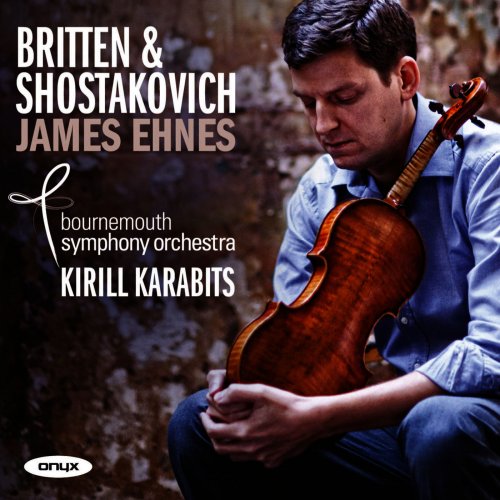
Bournemouth Symphony Orchestra, Kirill Karabits, James Ehnes - Britten & Shostakovich: Violin Concertos (2013)
BAND/ARTIST: Bournemouth Symphony Orchestra, Kirill Karabits, James Ehnes
- Title: Britten & Shostakovich: Violin Concertos
- Year Of Release: 2013
- Label: Onyx Classics
- Genre: Classical
- Quality: flac lossless
- Total Time: 01:06:54
- Total Size: 282 mb
- WebSite: Album Preview
Tracklist
---------
01. Violin Concerto, Op. 15 I. Moderato con moto
02. Violin Concerto, Op. 15 II. Vivace - Cadenza
03. Violin Concerto, Op. 15 III. Passcaglia Andante lento (Un poco meno mosso)
04. Violin Concerto No. 1 in A Minor, Op. 77 I. Nocturne Moderato
05. Violin Concerto No. 1 in A Minor, Op. 77 II. Scherzo Allegro
06. Violin Concerto No. 1 in A Minor, Op. 77 III. Passacaglia Andante
07. Violin Concerto No. 1 in A Minor, Op. 77 Cadenza
08. Violin Concerto No. 1 in A Minor, Op. 77 IV. Burlesque Allegro con brio - Presto
After a series of critically acclaimed recordings on ONYX, most recently of the Mendelssohn (ONYX4060) and the Tchaikovsky concertos (ONYX4076), James Ehnes teams up with the Bournemouth Symphony Orchestra and its charismatic music director, Kirill Karabits, in Violin Concertos by Benjamin Britten and Dmitri Shostakovich.
The Britten an early work, was completed in the September of 1939, just as World War II broke out. Britten had already composed 'Our Hunting Fathers' in 1935 (words by W.H Auden), and this work’s ferocious condemnation of political extremism and man’s inhumanity can to some extent be detected in the concerto. The barbarity of the Spanish Civil War (the concerto was written for the young Spanish violinist Antonio Brosa), the rise of Hitler’s Nazis and the persecution of the Jews appalled Britten. Peace and reconciliation was his credo, as exemplified in the later 'War Requiem'. In the scherzo tuba and piccolos present the listener with an image of the horrifying abyss mankind was lurching towards.
The first of Shostakovich’s two violin concertos was composed in 1948 for David Oistrakh. It had to wait until 1955 for its premiere due to the ban on ‘serious’ music by the notorious Zhdanov Conference and Party Decree of 1948. Only ‘patriotic’ music was allowed. With Stalin’s death in 1953 Shostakovich was finally able to exert his artistic freedom. It is a truly symphonic work in scale, grand, dramatic and cast in four movements with a huge cadenza placed before the finale.
---------
01. Violin Concerto, Op. 15 I. Moderato con moto
02. Violin Concerto, Op. 15 II. Vivace - Cadenza
03. Violin Concerto, Op. 15 III. Passcaglia Andante lento (Un poco meno mosso)
04. Violin Concerto No. 1 in A Minor, Op. 77 I. Nocturne Moderato
05. Violin Concerto No. 1 in A Minor, Op. 77 II. Scherzo Allegro
06. Violin Concerto No. 1 in A Minor, Op. 77 III. Passacaglia Andante
07. Violin Concerto No. 1 in A Minor, Op. 77 Cadenza
08. Violin Concerto No. 1 in A Minor, Op. 77 IV. Burlesque Allegro con brio - Presto
After a series of critically acclaimed recordings on ONYX, most recently of the Mendelssohn (ONYX4060) and the Tchaikovsky concertos (ONYX4076), James Ehnes teams up with the Bournemouth Symphony Orchestra and its charismatic music director, Kirill Karabits, in Violin Concertos by Benjamin Britten and Dmitri Shostakovich.
The Britten an early work, was completed in the September of 1939, just as World War II broke out. Britten had already composed 'Our Hunting Fathers' in 1935 (words by W.H Auden), and this work’s ferocious condemnation of political extremism and man’s inhumanity can to some extent be detected in the concerto. The barbarity of the Spanish Civil War (the concerto was written for the young Spanish violinist Antonio Brosa), the rise of Hitler’s Nazis and the persecution of the Jews appalled Britten. Peace and reconciliation was his credo, as exemplified in the later 'War Requiem'. In the scherzo tuba and piccolos present the listener with an image of the horrifying abyss mankind was lurching towards.
The first of Shostakovich’s two violin concertos was composed in 1948 for David Oistrakh. It had to wait until 1955 for its premiere due to the ban on ‘serious’ music by the notorious Zhdanov Conference and Party Decree of 1948. Only ‘patriotic’ music was allowed. With Stalin’s death in 1953 Shostakovich was finally able to exert his artistic freedom. It is a truly symphonic work in scale, grand, dramatic and cast in four movements with a huge cadenza placed before the finale.
As a ISRA.CLOUD's PREMIUM member you will have the following benefits:
- Unlimited high speed downloads
- Download directly without waiting time
- Unlimited parallel downloads
- Support for download accelerators
- No advertising
- Resume broken downloads


